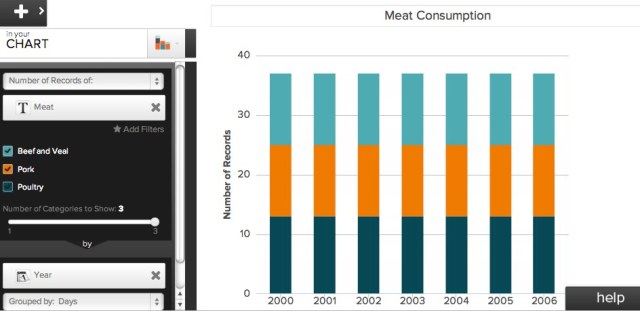Datahero, here at Disrupt NY, represents how the market is segmenting for data visualization and data-analytics tools based upon level of skill, complexity and overall richness and sophistication of the technology.
Datahero caters to a market that often has to rely on data analysts to do their work for them. Deal flows and other segmentations have traditionally required the help of someone who is familiar with a base understanding of statistics and software suites such as SPSS.
Chris Neuman, CEO and Co-Founder at Datahero, was the first engineer hired by Aster Data Systems, which was acquired by Teradata in 2011. He said to me in an email in late March that the main goal for Datahero is to enable anyone of any ability to be able to make sense of the data that matters to them – regardless of whether it’s in a data warehouse, on their laptop, or in a SaaS service.
Here’s a chart about meat consumption I created with a sample data set from Datahero. It was essentially a drag-and-drop exercise.
Datahero is in contrast to platforms such as Tableau Software, which require a deeper level of knowledge for how to use its platform. With more complexity comes more richness in what is possible to do. But for most of us, we just need to get the work done.
There are also a number of vendors that offer data visualization tools that are less complex than technologies like SPSS but not as simple as Datahero. Good Data, Birst and services such as Bime Analytics offer tools that have different levels of complexity. Chartio is simpler than most of these tools but does require integration with a customer’s data sources.
Good Data offers what it calls “Bashes,” which are pre-configured templates to analyze company data. A customer gets support from Good Data with integrating the company data. Companies then track, segment and target their data using the Good Data platform.
Datahero appeals to the novice user. But the platforms available in the market show the range of tools available for people with varying skill sets. That’s good for the market, especially as data becomes more plentiful and accessible to use.

